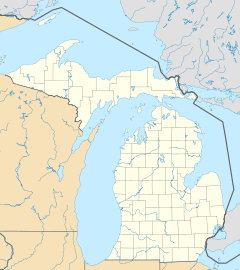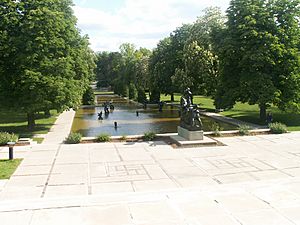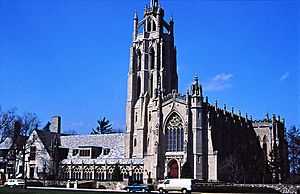Bloomfield Hills, Michigan facts for kids
Quick facts for kids
Bloomfield Hills, Michigan
|
||
|---|---|---|
| City of Bloomfield Hills | ||
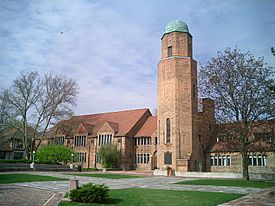
|
||
|
||
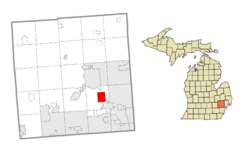
Location within Oakland County
|
||
| Country | United States | |
| State | Michigan | |
| County | Oakland | |
| Incorporated | 1927 (village) 1932 (city) |
|
| Government | ||
| • Type | Council–manager | |
| Area | ||
| • City | 5.04 sq mi (13.05 km2) | |
| • Land | 4.96 sq mi (12.84 km2) | |
| • Water | 0.08 sq mi (0.21 km2) | |
| Elevation | 833 ft (254 m) | |
| Population
(2010)
|
||
| • City | 3,869 | |
| • Estimate
(2019)
|
3,997 | |
| • Density | 806.01/sq mi (311.20/km2) | |
| • Metro | 4,296,250 (Metro Detroit) | |
| Time zone | UTC-5 (EST) | |
| • Summer (DST) | UTC-4 (EDT) | |
| ZIP code(s) |
48304
|
|
| Area codes | 248 and 947 | |
| FIPS code | 26-09180 | |
| GNIS feature ID | 0621616 | |
Bloomfield Hills is a small city (5.04 sq. miles) in Oakland County in the U.S. state of Michigan. It is a northern suburb of Metro Detroit and is approximately 20 miles (32 km) northwest of Downtown Detroit. Except a small southern border with the city of Birmingham, the city is almost completely surrounded by Bloomfield Township, but the city and township are administered autonomously. As of the 2010 census, the city's population was 3,869.
Contents
History
On June 28, 1820, Oakland County was divided into two townships: Pontiac Township and Bloomfield Township, the latter covering the southern part of the county that would include West Bloomfield Township, Royal Oak and Southfield. What is now Bloomfield Hills was a farming area until the turn of the 20th century when wealthy Detroit residents bought up the land. The settlement became a village in 1927, and in 1932 residents voted to become a city to avoid being incorporated into growing Birmingham.
Culture
Bloomfield Hills is the location of the National Historic Landmark Cranbrook Educational Community and other historic sites listed on the national register of historic places.
In popular culture, Bloomfield Hills was the setting for the 2005 film The Upside of Anger. In the 2002 film 8 Mile, Eminem mentions Cranbrook Kingswood while making fun of "Doc" because he attended Cranbrook, which is not considered cool or impressive in the atmosphere portrayed in the film. Bloomfield Hills is the hometown of the comic book character, Trance. Some scenes in Out of Sight with Jennifer Lopez and George Clooney were filmed at a private residence in Bloomfield Hills. (In the novel by Elmore Leonard on which the film is based, the most prominent street in Bloomfield Hills is described as “Vaughan Road, nothing but money.”) Jimmy Hoffa was last seen at the former Machus Red Fox restaurant in adjacent Bloomfield Township. The novel Gilda Joyce: The Ladies of the Lake is set in a private school in Bloomfield.
Churches
The area is the home of landmark churches including Kirk in the Hills Presbyterian on Long Lake Rd (Bloomfield Township) and Christ Church Cranbrook Episcopal, consecrated in 1928 as part of George Booth's plan for the Cranbrook Educational Community. The Congregational Church of Birmingham United Church of Christ was founded in Birmingham but moved to its present location in at 1000 Cranbrook Road (at Woodward Avenue) in Bloomfield Hills in 1966. St. Hugo of the Hills Roman Catholic Church' was funded by Theodore F. MacManus (1872–1940) and his wife in memory of their deceased children, Hugo and Hubert. St. Hugo of the Hills Catholic Church was built from 1931–1936, with approval from Bishop Michael J. Gallagher, and was designed by Arthur DesRossiers. Other churches include St. George Greek Orthodox, Bloomfield Hills Baptist, Beautiful Savior Lutheran Church (ELCA) on Adams Road (Bloomfield Township), Detroit Michigan Temple of The Church of Jesus Christ of Latter-day Saints, and Birmingham Unitarian Church on Woodward Avenue.
Geography
According to the United States Census Bureau, the city has a total area of 5.04 square miles (13.05 km2), of which 4.96 square miles (12.85 km2) is land and 0.08 square miles (0.21 km2) is water.
Demographics
| Historical population | |||
|---|---|---|---|
| Census | Pop. | %± | |
| 1930 | 1,127 | — | |
| 1940 | 1,281 | 13.7% | |
| 1950 | 1,468 | 14.6% | |
| 1960 | 2,378 | 62.0% | |
| 1970 | 3,672 | 54.4% | |
| 1980 | 3,985 | 8.5% | |
| 1990 | 4,288 | 7.6% | |
| 2000 | 3,940 | −8.1% | |
| 2010 | 3,869 | −1.8% | |
| 2019 (est.) | 3,997 | 3.3% | |
| U.S. Decennial Census | |||
As of the 2005–2009 American Community Survey 5-Year Estimates, there were 3,774 people, 1,570 households, and about 1,382 families living in the city. The population density was 796.4 per square mile (307.3/km2). There were 1,628 housing units at an average density of 329.1 per square mile (127.0/km2). The racial makeup of the city was 89.1% White, 5.4% Asian, 4.3% Black, 0.8% from other races, and 0.4% from two or more races. Hispanic or Latino of any race were 2.2% of the population.
2010 census
As of the census of 2010, there were 3,869 people, 1,489 households, and 1,116 families living in the city. The population density was 780.0 inhabitants per square mile (301.2/km2). There were 1,659 housing units at an average density of 334.5 per square mile (129.2/km2). The racial makeup of the city was 87.3% White, 6.7% Asian, 4.1% African American, 0.1% Native American, 0.3% from other races, and 1.6% from two or more races. Hispanic or Latino of any race were 1.5% of the population.
There were 1,489 households, of which 25.7% had children under the age of 18 living with them, 67.7% were married couples living together, 4.9% had a female householder with no husband present, 2.4% had a male householder with no wife present, and 25.1% were non-families. 21.8% of all households were made up of individuals, and 13% had someone living alone who was 65 years of age or older. The average household size was 2.44 and the average family size was 2.84.
The median age in the city was 54.1 years. 19.9% of residents were under the age of 18; 4.8% were between the ages of 18 and 24; 11.8% were from 25 to 44; 33.5% were from 45 to 64; and 29.7% were 65 years of age or older. The gender makeup of the city was 49.0% male and 51.0% female.
Economy
Acme Group, consisting of Acme Mills, Great Lakes Filters, and Fairway Products, is headquartered in Bloomfield Hills. Other companies headquartered in Bloomfield Hills, MI include Taubman Centers, TriMas Corp., Larson Realty Group, Princeton Enterprises, TIP Capital, Bloomfield Hills Bancorp, Reverie, BlackEagle Partners, Gregory J. Schwartz & Co., Inc., Alidade Capital, Penske Automotive Group, and O2 Investment Partners.
Education
Primary and secondary schools
Public schools
Most of the city is served by the Bloomfield Hills School District (BHSD), a public school district based in neighboring Bloomfield Township, comprising the City of Bloomfield Hills, most of Bloomfield Township, and small parts of neighboring communities such as Auburn Hills, Troy, and West Bloomfield Township. The sole district comprehensive high school is Bloomfield Hills High School, formed in 2013 by the mergers of Andover High School and Lahser High School.
The Bloomfield Hills district administers the International Academy, a tuition-free, public consortium high school in Bloomfield Township that hosts students from ten different public schools districts (including some Bloomfield Hills School District students).
A southern portion of Bloomfield Hills resides in the Birmingham City School District.
Private schools
The Bloomfield Hills area is also home to many private schools. The city limits include the nonsectarian Cranbrook Schools, Cranbrook Academy of Art, St. Hugo of the Hills Catholic School (established in 1940), and the Roeper School.
The neighboring communities of Bloomfield Township and Beverly Hills have two single-sex Catholic schools: Brother Rice High School for boys and Marian High School for girls, as well as the private college-preparatory school Detroit Country Day School, Academy of the Sacred Heart.
Weekend education
After the Japanese School of Detroit was formed in 1973, it initially held its classes at Cranbrook School Brookside.
Post-secondary education
Bloomfield Hills is home to the Cranbrook Academy of Art, one of the nation's leading graduate schools of architecture, art and design. It was founded by the Booths in 1932. By 1984, the New York Times would say that "the effect of Cranbrook and its graduates and faculty on the physical environment of this country has been profound ... Cranbrook, surely more than any other institution, has a right to think of itself as synonymous with contemporary American design."
The main offices of Oakland Community College are in Bloomfield Hills.
Notable people
Images for kids
See also
 In Spanish: Bloomfield Hills para niños
In Spanish: Bloomfield Hills para niños



